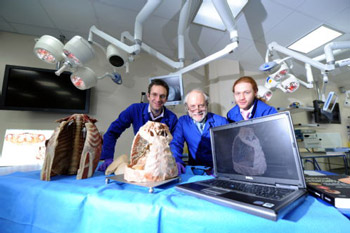3-D anatomy aid shortlisted for national education award
 A world-first 3D anatomy learning resource created by the University of Warwick and University Hospitals Coventry and Warwickshire NHS Trust (UHCW) has been shortlisted for a national education award.
A world-first 3D anatomy learning resource created by the University of Warwick and University Hospitals Coventry and Warwickshire NHS Trust (UHCW) has been shortlisted for a national education award.
The learning program, which consists of 3D images of some of the University’s collection of prosected and plastinated body parts, has been shortlisted for a Times Higher Education Award 2012 in the Outstanding ICT initiative category.
Due to curriculum time restraints medical students have restricted access to the prosections, which are stored at the West Midlands Surgical Training Centre (WMSTC) at University Hospital, Coventry. This new online resource allows students to have constant access to 3D moving rotations of specimens and review anatomy in great detail on their ipad or smartphone.
Warwick Medical School student Mark Mobley combined his previous experience and physics degree working on 3D animations to create the resource, with the help of the University Clinical Anatomist, Professor Peter Abrahams and Brian Burnett, the WMSTC manager at UHCW.
Professor Abrahams said: “At long last our students can study anatomy on the move, and it gives me a real pride to see them in coffee breaks, on the beach and even sitting in an airport lounge studying detailed real human anatomy in moving 3D from their smart phones. I wish I had been able to have technology like this as a student.”
Mark Mobley worked closely with Brian Burnett at the WMSTC, where much of their anatomy teaching takes place. The combined effort means that there are now more than a dozen 3D prosections that can be rotated and viewed with various technical controls even on a smart phone.
Mark said: “We hope this will become an excellent resource for medical students. As the prosections have restricted access and are vulnerable to damage over time, this new tool means they will be available for students and medical professionals to study at the time and place of their choosing.
“Although there are already many specimens to view, there are now plans to extend this to include the complete library of plastinates, as well as future dissected specimens and acquisitions of Warwick Medical School.”
Brian added: “People have donated their bodies to science to improve healthcare for future generations, now this learning experience need not be limited to small groups inside the walls of the hospital. Adding this technology allows students and health professionals to learn about the wonder of the human body at their own pace. This resource is a superb addition to educating doctors and surgeons worldwide and another superb example of collaborative working between UHCW and University of Warwick.”
The winners of the award will be announced on Thursday 29 November at a ceremony in London.
Notes to editors
For more details contact Kelly Parkes-Harrison, k.e.parkes@warwick.ac.uk, 02476 150868, 07824 540863
